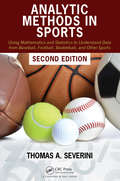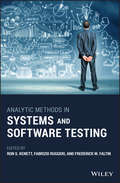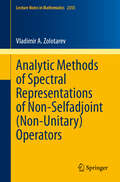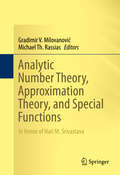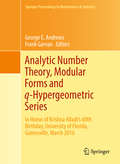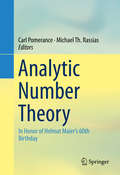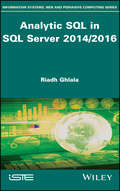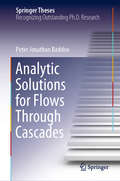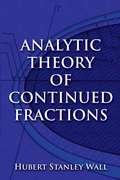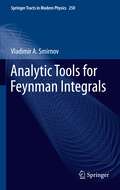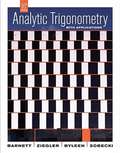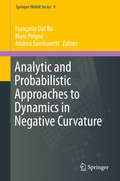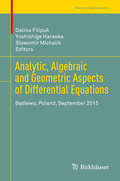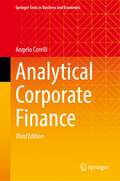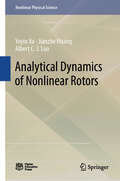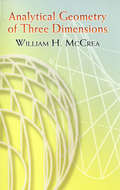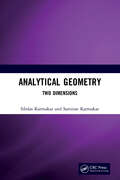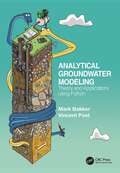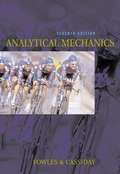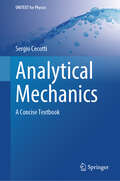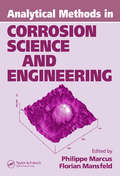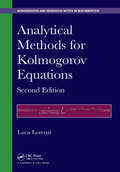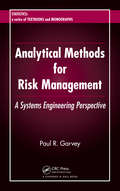- Table View
- List View
Analytic Methods in Sports: Using Mathematics and Statistics to Understand Data from Baseball, Football, Basketball, and Other Sports
by Thomas A. SeveriniOne of the greatest changes in the sports world in the past 20 years has been the use of mathematical methods to analyze performances, recognize trends and patterns, and predict results. Analytic Methods in Sports: Using Mathematics and Statistics to Understand Data from Baseball, Football, Basketball, and Other Sports, Second Edition provides a concise yet thorough introduction to the analytic and statistical methods that are useful in studying sports. The book gives you all the tools necessary to answer key questions in sports analysis. It explains how to apply the methods to sports data and interpret the results, demonstrating that the analysis of sports data is often different from standard statistical analyses. The book integrates a large number of motivating sports examples throughout and offers guidance on computation and suggestions for further reading in each chapter. Features Covers numerous statistical procedures for analyzing data based on sports results Presents fundamental methods for describing and summarizing data Describes aspects of probability theory and basic statistical concepts that are necessary to understand and deal with the randomness inherent in sports data Explains the statistical reasoning underlying the methods Illustrates the methods using real data drawn from a wide variety of sports Offers many of the datasets on the author’s website, enabling you to replicate the analyses or conduct related analyses New to the Second Edition R code included for all calculations A new chapter discussing several more advanced methods, such as binary response models, random effects, multilevel models, spline methods, and principal components analysis, and more Exercises added to the end of each chapter, to enable use for courses and self-study Full solutions manual available to course instructors.
Analytic Methods in Systems and Software Testing
by Fabrizio Ruggeri Ron S. Kenett Frederick W. FaltinA comprehensive treatment of systems and software testing using state of the art methods and tools This book provides valuable insights into state of the art software testing methods and explains, with examples, the statistical and analytic methods used in this field. Numerous examples are used to provide understanding in applying these methods to real-world problems. Leading authorities in applied statistics, computer science, and software engineering present state-of-the-art methods addressing challenges faced by practitioners and researchers involved in system and software testing. Methods include: machine learning, Bayesian methods, graphical models, experimental design, generalized regression, and reliability modeling. Analytic Methods in Systems and Software Testing presents its comprehensive collection of methods in four parts: Part I: Testing Concepts and Methods; Part II: Statistical Models; Part III: Testing Infrastructures; and Part IV: Testing Applications. It seeks to maintain a focus on analytic methods, while at the same time offering a contextual landscape of modern engineering, in order to introduce related statistical and probabilistic models used in this domain. This makes the book an incredibly useful tool, offering interesting insights on challenges in the field for researchers and practitioners alike. Compiles cutting-edge methods and examples of analytical approaches to systems and software testing from leading authorities in applied statistics, computer science, and software engineering Combines methods and examples focused on the analytic aspects of systems and software testing Covers logistic regression, machine learning, Bayesian methods, graphical models, experimental design, generalized regression, and reliability models Written by leading researchers and practitioners in the field, from diverse backgrounds including research, business, government, and consulting Stimulates research at the theoretical and practical level Analytic Methods in Systems and Software Testing is an excellent advanced reference directed toward industrial and academic readers whose work in systems and software development approaches or surpasses existing frontiers of testing and validation procedures. It will also be valuable to post-graduate students in computer science and mathematics.
Analytic Methods of Spectral Representations of Non-Selfadjoint (Lecture Notes in Mathematics #2355)
by Vladimir A. ZolotarevThis book is concerned with the theory of model representations of linear non-selfadjoint and non-unitary operators. This booming area of functional analysis owes its origins to the fundamental works of M. S. Livšic on the theory of characteristic functions, the deep studies of B. S.-Nagy and C. Foias on dilation theory, and also to the Lax–Phillips scattering theory. Here, a uniform conceptual approach is developed which organically unites all these theories. New analytic methods are introduced which make it possible to solve some important problems from the theory of spectral representations. Aimed at specialists in functional analysis, the book will also be accessible to senior mathematics students.
Analytic Number Theory, Approximation Theory, and Special Functions: In Honor of Hari M. Srivastava
by Michael Th. Rassias Gradimir V. MilovanovićThis book, in honor of Hari M. Srivastava, discusses essential developments in mathematical research in a variety of problems. It contains thirty-five articles, written by eminent scientists from the international mathematical community, including both research and survey works. Subjects covered include analytic number theory, combinatorics, special sequences of numbers and polynomials, analytic inequalities and applications, approximation of functions and quadratures, orthogonality and special and complex functions. The mathematical results and open problems discussed in this book are presented in a simple and self-contained manner. The book contains an overview of old and new results, methods, and theories toward the solution of longstanding problems in a wide scientific field, as well as new results in rapidly progressing areas of research. The book will be useful for researchers and graduate students in the fields of mathematics, physics and other computational and applied sciences.
Analytic Number Theory, Modular Forms and q-Hypergeometric Series: In Honor of Krishna Alladi's 60th Birthday, University of Florida, Gainesville, March 2016 (Springer Proceedings in Mathematics & Statistics #221)
by George E. Andrews Frank GarvanGathered from the 2016 Gainesville Number Theory Conference honoring Krishna Alladi on his 60th birthday, these proceedings present recent research in number theory. Extensive and detailed, this volume features 40 articles by leading researchers on topics in analytic number theory, probabilistic number theory, irrationality and transcendence, Diophantine analysis, partitions, basic hypergeometric series, and modular forms. Readers will also find detailed discussions of several aspects of the path-breaking work of Srinivasa Ramanujan and its influence on current research. Many of the papers were motivated by Alladi's own research on partitions and q-series as well as his earlier work in number theory. <P><P> Alladi is well known for his contributions in number theory and mathematics. His research interests include combinatorics, discrete mathematics, sieve methods, probabilistic and analytic number theory, Diophantine approximations, partitions and q-series identities. Graduate students and researchers will find this volume a valuable resource on new developments in various aspects of number theory.
Analytic Number Theory: In Honor of Helmut Maier’s 60th Birthday
by Michael Th. Rassias Carl PomeranceThis volume contains a collection of research and survey papers written by some of the most eminent mathematicians in the international community and is dedicated to Helmut Maier, whose own research has been groundbreaking and deeply influential to the field. Specific emphasis is given to topics regarding exponential and trigonometric sums and their behavior in short intervals, anatomy of integers and cyclotomic polynomials, small gaps in sequences of sifted prime numbers, oscillation theorems for primes in arithmetic progressions, inequalities related to the distribution of primes in short intervals, the Möbius function, Euler's totient function, the Riemann zeta function and the Riemann Hypothesis. Graduate students, research mathematicians, as well as computer scientists and engineers who are interested in pure and interdisciplinary research, will find this volume a useful resource. Contributors to this volume: Bill Allombert, Levent Alpoge, Nadine Amersi, Yuri Bilu, Régis de la Bretèche, Christian Elsholtz, John B. Friedlander, Kevin Ford, Daniel A. Goldston, Steven M. Gonek, Andrew Granville, Adam J. Harper, Glyn Harman, D. R. Heath-Brown, Aleksandar Ivi, Geoffrey Iyer, Jerzy Kaczorowski, Daniel M. Kane, Sergei Konyagin, Dimitris Koukoulopoulos, Michel L. Lapidus, Oleg Lazarev, Andrew H. Ledoan, Robert J. Lemke Oliver, Florian Luca, James Maynard, Steven J. Miller, Hugh L. Montgomery, Melvyn B. Nathanson, Ashkan Nikeghbali, Alberto Perelli, Amalia Pizarro-Madariaga, János Pintz, Paul Pollack, Carl Pomerance, Michael Th. Rassias, Maksym Radziwi, Joël Rivat, András Sárközy, Jeffrey Shallit, Terence Tao, Gérald Tenenbaum, László Tóth, Tamar Ziegler, Liyang Zhang.
Analytic Pattern Matching
by Philippe Jacquet Wojciech SzpankowskiHow do you distinguish a cat from a dog by their DNA? Did Shakespeare really write all of his plays? Pattern matching techniques can offer answers to these questions and to many others, from molecular biology, to telecommunications, to classifying Twitter content. This book for researchers and graduate students demonstrates the probabilistic approach to pattern matching, which predicts the performance of pattern matching algorithms with very high precision using analytic combinatorics and analytic information theory. Part I compiles known results of pattern matching problems via analytic methods. Part II focuses on applications to various data structures on words, such as digital trees, suffix trees, string complexity and string-based data compression. The authors use results and techniques from Part I and also introduce new methodology such as the Mellin transform and analytic depoissonization. More than 100 end-of-chapter problems help the reader to make the link between theory and practice.
Analytic SQL in SQL Server 2014/2016
by Riadh GhlalaBusiness Intelligence (BI) has emerged as a field which seeks to support managers in decision-making. It encompasses the techniques, methods and tools for conducting analytically-based IT solutions, which are referred to as OLAP (OnLine Analytical Processing). Within this field, SQL has a role as a leader and is continuously evolving to cover both transactional and analytical data management. This book discusses the functions provided by Microsoft® SQL Server 2014/2016 in terms of business intelligence. The analytic functions are considered as an enrichment of the SQL language. They combine a series of practical functions to answer complex analysis requests with all the simplicity, elegance and acquired performance of the SQL language. Drawing on the wide experience of the author in teaching and research, as well as insights from contacts in the industry, this book focuses on the issues and difficulties faced by academics (students and teachers) and professionals engaged in data analysis with the SQL Server 2014/2016 database management system.
Analytic Semigroups and Semilinear Initial Boundary Value Problems
by Kazuaki TairaThis book provides a careful and accessible exposition of the function analytic approach to initial boundary value problems for semilinear parabolic differential equations. It focuses on the relationship between two interrelated subjects in analysis: analytic semigroups and initial boundary value problems. This semigroup approach can be traced back to the pioneering work of Fujita and Kato on the Navier-Stokes equation. The author studies non homogeneous boundary value problems for second order elliptic differential operators, in the framework of Sobolev spaces of Lp style, which include as particular cases the Dirichlet and Neumann problems, and proves that these boundary value problems provide an example of analytic semigroups in Lp. This book will be a necessary purchase for researchers with an interest in analytic semigroups or initial value problems.
Analytic Solutions for Flows Through Cascades (Springer Theses)
by Peter Jonathan BaddooThis thesis is concerned with flows through cascades, i.e. periodic arrays of obstacles. Such geometries are relevant to a range of physical scenarios, chiefly the aerodynamics and aeroacoustics of turbomachinery flows. Despite the fact that turbomachinery is of paramount importance to a number of industries, many of the underlying mechanisms in cascade flows remain opaque. In order to clarify the function of different physical parameters, the author considers six separate problems. For example, he explores the significance of realistic blade geometries in predicting turbomachinery performance, and the possibility that porous blades can achieve noise reductions. In order to solve these challenging problems, the author deploys and indeed develops techniques from across the spectrum of complex analysis: the Wiener–Hopf method, Riemann–Hilbert problems, and the Schottky–Klein prime function all feature prominently. These sophisticated tools are then used to elucidate the underlying mathematical and physical structures present in cascade flows. The ensuing solutions greatly extend previous works and offer new avenues for future research. The results are not of simply academic value but are also useful for aircraft designers seeking to balance aeroacoustic and aerodynamic effects.
Analytic Theory of Continued Fractions (Dover Books on Mathematics)
by Hubert Stanley WallOne of the most authoritative and comprehensive books on the subject of continued fractions, this monograph has been widely used by generations of mathematicians and their students. Dr. Hubert Stanley Wall presents a unified theory correlating certain parts and applications of the subject within a larger analytic structure. Prerequisites include a first course in function theory and knowledge of the elementary properties of linear transformations in the complex plane. Some background in number theory, real analysis, and complex analysis may also prove helpful. The two-part treatment begins with an exploration of convergence theory, addressing continued fractions as products of linear fractional transformations, convergence theorems, and the theory of positive definite continued fractions, as well as other topics. The second part, focusing on function theory, covers the theory of equations, matrix theory of continued fractions, bounded analytic functions, and many additional subjects.
Analytic Tools for Feynman Integrals (Springer Tracts in Modern Physics #250)
by Vladimir A. SmirnovThe goal of this book is to describe the most powerful methods for evaluating multiloop Feynman integrals that are currently used in practice. This book supersedes the author's previous Springer book "Evaluating Feynman Integrals" and its textbook version "Feynman Integral Calculus." Since the publication of these two books, powerful new methods have arisen and conventional methods have been improved on in essential ways. A further qualitative change is the fact that most of the methods and the corresponding algorithms have now been implemented in computer codes which are often public. In comparison to the two previous books, three new chapters have been added: One is on sector decomposition, while the second describes a new method by Lee. The third new chapter concerns the asymptotic expansions of Feynman integrals in momenta and masses, which were described in detail in another Springer book, "Applied Asymptotic Expansions in Momenta and Masses," by the author. This chapter describes, on the basis of papers that appeared after the publication of said book, how to algorithmically discover the regions relevant to a given limit within the strategy of expansion by regions. In addition, the chapters on the method of Mellin-Barnes representation and on the method of integration by parts have been substantially rewritten, with an emphasis on the corresponding algorithms and computer codes.
Analytic Trigonometry with Applications (10th Edition)
by Raymond A. Barnett Michael R. Ziegler Karl E. Byleen Dave SobeckiThe 10th edition of Analytic Trigonometry with Applications is designed for a one-term course in trigonometry and for students who have had 1 1/2-2 years of high school algebra or the equivalent.
Analytic and Probabilistic Approaches to Dynamics in Negative Curvature (Springer INdAM Series #9)
by Françoise Dal'Bo Marc Peigné Andrea SambusettiThe work consists of two introductory courses, developing different points of view on the study of the asymptotic behaviour of the geodesic flow, namely: the probabilistic approach via martingales and mixing (by Stéphane Le Borgne); the semi-classical approach, by operator theory and resonances (by Frédéric Faure and Masato Tsujii). The contributions aim to give a self-contained introduction to the ideas behind the three different approaches to the investigation of hyperbolic dynamics. The first contribution focus on the convergence towards a Gaussian law of suitably normalized ergodic sums (Central Limit Theorem). The second one deals with Transfer Operators and the structure of their spectrum (Ruelle-Pollicott resonances), explaining the relation with the asymptotics of time correlation function and the periodic orbits of the dynamics.
Analytic, Algebraic and Geometric Aspects of Differential Equations: Będlewo, Poland, September 2015 (Trends in Mathematics)
by Galina Filipuk Yoshishige Haraoka Sławomir MichalikThis volume consists of invited lecture notes, survey papers and original research papers from the AAGADE school and conference held in Będlewo, Poland in September 2015. The contributions provide an overview of the current level of interaction between algebra, geometry and analysis and demonstrate the manifold aspects of the theory of ordinary and partial differential equations, while also pointing out the highly fruitful interrelations between those aspects. These interactions continue to yield new developments, not only in the theory of differential equations but also in several related areas of mathematics and physics such as differential geometry, representation theory, number theory and mathematical physics. The main goal of the volume is to introduce basic concepts, techniques, detailed and illustrative examples and theorems (in a manner suitable for non-specialists), and to present recent developments in the field, together with open problems for more advanced and experienced readers. It will be of interest to graduate students, early-career researchers and specialists in analysis, geometry, algebra and related areas, as well as anyone interested in learning new methods and techniques.
Analytical Corporate Finance (Springer Texts in Business and Economics)
by Angelo CorelliThis book draws readers’ attention to the financial aspects of daily life at a corporation by combining a robust mathematical setting and the explanation and derivation of the most popular models of the firm. Intended for third-year undergraduate students of business finance, quantitative finance, and financial mathematics, as well as first-year postgraduate students, it is based on the twin pillars of theory and analytics, which merge in a way that makes it easy for students to understand the exact meaning of the concepts and their representation and applicability in real-world contexts. Examples are given throughout the chapters in order to clarify the most intricate aspects; where needed, there are appendices at the end of chapters, offering additional mathematical insights into specific topics. Due to the recent growth in knowledge demand in the private sector, practitioners can also profit from the book as a bridge-builder between university and industry. Lastly, the book provides useful information for managers who want to deepen their understanding of risk management and come to recognize what may have been lacking in their own systems.
Analytical Dynamics of Nonlinear Rotors (Nonlinear Physical Science)
by Albert C. Luo Yeyin Xu Jianzhe HuangThis book is a monograph about the analytical dynamics of nonlinear rotor systems. The analytical solutions of periodic motions in nonlinear rotor systems are presented in this book. To help one understand the analytical solutions, the generalized harmonic balance method for periodic motions in polynomial nonlinear systems is briefly reviewed first, and then the semi-analytical method for periodic motions in any nonlinear systems is presented briefly too, which is also called the implicit mapping method. Such two analytical methods are employed to determine the solutions of periodic motions in nonlinear rotor systems. The analytical expressions of periodic motions to chaos for nonlinear rotor systems are presented, and the frequency-amplitude characteristics of nonlinear rotor systems are discussed. In addition, the accurate modeling of nonlinear rotors with oil films is presented, and the periodic motions of such fully nonlinear oil-film rotor systems are developed through the semi-analytical method. This book provides a better understanding of frequency-amplitude characteristics in nonlinear rotor systems. The methodology presented in this book can help one study complicated nonlinear rotor systems.
Analytical Geometry of Three Dimensions: Second Revised Version
by William H. McCreaBrief but rigorous, this text is geared toward advanced undergraduates and graduate students. It covers the coordinate system, planes and lines, spheres, homogeneous coordinates, general equations of the second degree, quadric in Cartesian coordinates, and intersection of quadrics.Mathematician, physicist, and astronomer, William H. McCrea conducted research in many areas and is best known for his work on relativity and cosmology. McCrea studied and taught at universities around the world, and this book is based on a series of his lectures.
Analytical Geometry: Two Dimensions
by Sibdas Karmakar Samiran KarmakarThis book is a compilation of all basic topics of Analytical Geometry of Two Dimensions and is intended to serve as an introductory text aimed towards undergraduate and graduate students in science and technology. An understanding of basic school level algebra and geometry can serve as the prerequisite for following this book. The present work is no original work but an attempt to make the subject thoroughly intelligible. All the important properties of the conics have been discussed either in the articles or in illustrative examples. Each chapter has sufficient completely solved problems and a set of carefully graded and motivating unsolved exercises. Please note: Taylor & Francis does not sell or distribute the Hardback in India, Pakistan, Nepal, Bhutan, Bangladesh and Sri Lanka.
Analytical Groundwater Modeling: Theory and Applications using Python
by Vincent Post Mark BakkerThis book provides a detailed description of how Python can be used to give insight into the flow of groundwater based on analytic solutions. Starting with simple problems to illustrate the basic principles, complexity is added step by step to show how one-dimensional and two-dimensional models of one or two aquifers can be implemented. Steady and transient flow problems are discussed in confined, semi-confined, and unconfined aquifers that may include wells, rivers, and areal recharge. Special consideration is given to coastal aquifers, including the effect of tides and the simulation of interface flow. Application of Python allows for compact and readable code, and quick visualization of the solutions. Python scripts are provided to reproduce all results. The scripts are also available online so that they can be altered to meet site-specific conditions. This book is intended both as training material for the next generation of university students and as a useful resource for practitioners. A primer is included for those who are new to Python or as a refresher for existing users.
Analytical Mechanics (Seventh Edition)
by Grant R. Fowles George L. CassidayThis textbook is intended for an undergraduate course in classical mechanics taken by students majoring in physics, physical science, or engineering.
Analytical Mechanics: A Concise Textbook (UNITEXT for Physics)
by Sergio CecottiThis textbook is based on the author's lecture notes held at Qiuzhen College, Tsinghua University, Beijing, renowned for its rapid scientific growth of its excellent students. The book offers a remarkable combination of characteristics that are both exceptional and seemingly contradictory. It is designed to be entirely self-contained, starting from the basics and building a strong foundation in geometric and algebraic tools. Simultaneously, topics are infused with mathematical elegance and profundity, employing contemporary language and techniques. From a physicist's perspective, the content delves deeply into the physical aspects, emphasizing the underlying principles. This book bridges the gap between students and cutting-edge research, with a special focus on symplectic geometry, integrability, and recent developments in the field. It is designed to engage and captivate the reader. A conscious selection of topics ensures a more relevant and contemporary approach compared to traditional textbooks. The book addresses common misconceptions, offering clarity and precision. In its quest for brevity, this book is tailored for a one-semester course, offering a comprehensive and concise resource. The author's dedication is evident throughout this volume, encapsulating these goals within roughly 300 pages.
Analytical Methods In Corrosion Science and Engineering (Corrosion Technology)
by Philippe Marcus Florian MansfeldDamage from corrosion costs billions of dollars per year. Controlling corrosion requires a fundamental, in-depth understanding of the mechanisms and phenomena involved, and this understanding is best achieved through advanced analytical methods. The first book to treat both surface analytical and electrochemical techniques in a single reference, An
Analytical Methods for Kolmogorov Equations (Chapman & Hall/CRC Monographs and Research Notes in Mathematics #25)
by Luca LorenziThe second edition of this book has a new title that more accurately reflects the table of contents. Over the past few years, many new results have been proven in the field of partial differential equations. This edition takes those new results into account, in particular the study of nonautonomous operators with unbounded coefficients, which has received great attention. Additionally, this edition is the first to use a unified approach to contain the new results in a singular place.
Analytical Methods for Risk Management: A Systems Engineering Perspective (Statistics: A Series of Textbooks and Monographs)
by Paul R. GarveyA Text on the Foundation Processes, Analytical Principles, and Implementation Practices of Engineering Risk ManagementDrawing from the author's many years of hands-on experience in the field, Analytical Methods for Risk Management: A Systems Engineering Perspectivepresents the foundation processes and analytical practices
